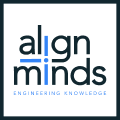MODIFIED ON: April 18, 2024 / ALIGNMINDS TECHNOLOGIES / 0 COMMENTS

In our modern, high-speed society, every moment counts, particularly in the realm of vehicle damage assessment. Whether you’re an insurance professional, a garage proprietor, or just a vehicle owner faced with an unforeseen accident, speed is crucial. Picture a scenario where you can simplify the entire procedure, conserving precious time and resources. This isn’t merely wishful thinking; it’s the practical outcome made possible by the integration of AI and computer vision technologies into the field of vehicle damage analysis.
Recent statistics reveal that Automated Vehicle Damage Detection combined with computer vision technology, has dramatically improved the accuracy and speed of damage assessment, reducing human error by up to 90%. In this blog, we’ll dive deep into the fascinating world of AI and computer vision, exploring how these technologies are revolutionizing vehicle damage analysis, and why you should be excited about it.
Let’s unlock the potential of efficiency together!
Challenges involved in traditional manual damage assessment methods

Traditional manual damage assessment methods face numerous challenges that hinder their efficiency and accuracy. These hurdles include:
Time-Consuming Process: Manual assessment is labor-intensive and time-consuming, requiring significant effort to inspect each damaged area thoroughly.
Limited Accessibility: Certain damaged areas might be inaccessible or unsafe for human assessors, hindering a comprehensive evaluation of the situation.
Subjectivity and Inconsistency: Assessments heavily depend on individual judgment, leading to subjective evaluations and inconsistent results among different assessors.
Data Accuracy: Relying on manual observations increases the risk of human error, impacting the accuracy of the collected data.
These challenges underscore the urgent need for automated and technologically advanced solutions to streamline the damage assessment process effectively.
The Power of AI and Computer Vision

Vehicle damage analysis has undergone a transformative shift with the integration of Artificial Intelligence (AI) and Computer Vision technologies. AI, the simulation of human intelligence in machines, and Computer Vision, enabling machines to interpret and make decisions based on visual data, converge to enhance vehicle damage assessment. Traditionally reliant on human inspectors, this innovative approach automates the process, significantly improving efficiency and accuracy.
AI algorithms process vast amounts of data, swiftly identifying and categorizing vehicle damages such as dents, scratches, or structural issues. Computer Vision further refines this analysis, enabling machines to “see” intricate details that might escape the human eye. Through image recognition and machine learning, these systems learn and adapt, continually enhancing their diagnostic capabilities. This technology’s real power lies in its ability to expedite insurance claims, reduce costs, and ensure fairer settlements.
Furthermore, these advancements lead to safer roads by enabling swift repairs, minimizing the time damaged vehicles spend on the streets. Beyond efficiency, AI and Computer Vision promote sustainability by facilitating eco-friendly practices, encouraging timely repairs, and reducing overall vehicle downtime.
Benefits of Leveraging AI and Computer Vision in Vehicle Damage Analysis
Automated image recognition and classification of damage types: AI and computer vision systems can swiftly analyze images of vehicle damage and accurately classify various types of issues, from dents to cracks. This speeds up the assessment process and ensures that no damage goes unnoticed, improving repair accuracy and customer satisfaction.
Speed and efficiency in processing large volumes of data: AI enables the rapid processing of vast datasets of vehicle damage images, significantly reducing the time required for assessment. This efficiency is especially valuable for insurance companies, repair shops, and automotive manufacturers dealing with high volumes of claims or inspections.
Improved accuracy and consistency in damage detection: AI systems consistently apply predefined criteria for damage detection, reducing the chances of human error or oversight. This ensures that assessments are more accurate and standardized across different evaluators and locations.
Reduction in human errors and biases: By relying on AI and computer vision, the analysis becomes less dependent on individual judgment, minimizing the risk of human errors and biases that can affect assessment outcomes. This results in fairer and more objective evaluations.
Cost savings and increased productivity: AI-driven vehicle damage analysis can lead to cost savings by streamlining the claims process and reducing the need for manual labor. Additionally, the faster assessment and repair authorization can increase overall productivity, benefiting both customers and service providers.
Embracing AI and Computer Vision: A Transformative Leap for the Automotive Industry
In conclusion, the integration of AI and computer vision technologies in vehicle damage analysis holds immense promise for the automotive industry. By streamlining the inspection process, reducing human error, and accelerating claims processing, these innovations are unlocking unprecedented efficiency. As we look to the future, it’s clear that these technologies will play a pivotal role in improving customer experiences, reducing costs, and ensuring safer roads. Embracing AI and computer vision is not just a technological advancement; it’s a transformative leap towards a more efficient and sustainable automotive ecosystem
Embrace AI and computer vision for a smarter automotive industry. Explore the future of efficiency and safety – join the transformation today!
Leave a reply
Your email address will not be published.
-
Recent Posts
- Unveiling the Future: The Role of AI in Spearheading Digital Transformation in 2024
- Chatbots vs. Conversational AI: Decoding the Mysteries Behind the Tech
- Leading the Pack: The Top Conversational AI Platforms Transforming Communication in 2024
- The Future of Work: Key Remote Staffing Trends Dominating 2024
- The Ultimate Guide to Choosing the Right Generative AI Company
-
Categories
- MVP Development (3)
- AlignMinds (55)
- Operating Systems (2)
- Android POS (3)
- Application Hosting (1)
- Artificial Intelligence (19)
- Big Data (2)
- Blockchain (1)
- Cloud Application Development (7)
- Software Development (30)
- Software Testing (9)
- Strategy & User Experience Design (4)
- Web Application Development (23)
- Cyber Security (6)
- Outsourcing (7)
- Programming Languages (3)
- DevOps (5)
- Software Designing (6)
- How to Code (4)
- Internet of Things (1)
- Machine Learning (2)
- Mobile App Marketing (4)
- Mobile Application Development (18)
- Mobile Applications (5)







